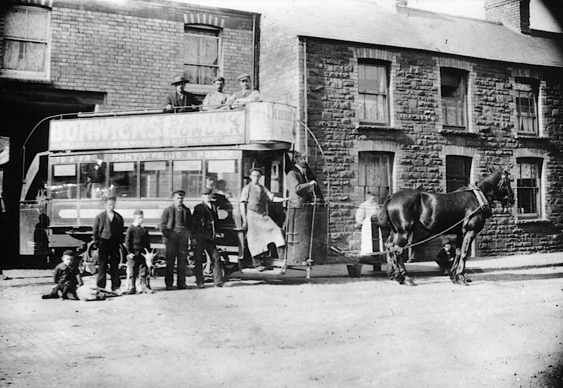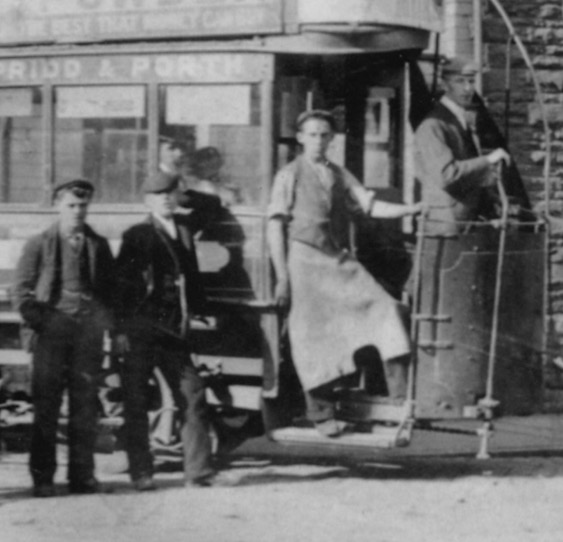Pontypridd and Rhondda Valley Tramway
History
The 3ft 6ins-gauge, horse-drawn Pontypridd and Rhondda Valley Tramway, which was owned by the Pontypridd and Rhondda Valley Tramway Company, was probably opened in March 1888, the precise date having evaded the historical record.
Although the company had grand plans to connect Pontypridd with Treherbert, it was under-capitalised from the start, so only a quarter of the projected line was ever built; this ran for 3.06 miles northwestwards from Pontypridd to Porth. The company even struggled to get this truncated section into operation, only managing to open it by virtue of an agreement with Solomon Andrews, a well-known Cardiff omnibus proprietor and budding tramway entrepreneur, who undertook to work the tramway. In fact, Andrews had to provide all the tramcars — the company not having enough money to buy any more than the one they already had purchased — as well as the horses and drivers; the company provided the conductors (and retained the takings), with Andrews receiving an agreed rate per car per mile.
With the tramway actually only transporting passengers between the outskirts of the two towns, money owed to contractors, and income short of expectations, it wasn't long before track maintenance dwindled to zero, and the complaints started to flood in. Perhaps inevitably, the financial situation reached the point where the company could no longer continue, and in 1890, it entered liquidation. The liquidator quickly reached agreement with Andrews for him to continue operating the tramway, pending a buyer being found.
The concern was put up for sale on the 12th August 1891, being advertised as a profitable venture (presumably if you hadn't had to borrow money first to build it), but the reserve was not reached. Six days later — on the 18th August 1891 — Solomon Andrews stepped in to buy the P&RVTCo using the rather oddly named South Wales Property, Machinery and Carriage Company, a concern which he owned; Andrews thus became the owner and the operator of the tramway.
The tramway was presumably operated successfully for the next eight years — Andrews was a very successful businessman — before being sold to the British Electric Traction Company Limited on the 29th September 1898.
At this time, the BETCo, which over the course of its existence, would either own, part-own or lease almost 50 tramway systems across the British Isles, was aggressively purchasing horse and steam-operated tramways, with the intention of converting them to electric traction. Unfortunately for the BETCo, their plans ran into serious opposition from numerous local interests, including Pontypridd Urban District Council, who though initially receptive, soon began to work on plans for their own electric tramway. The company eventually gave up, and went back to the business of operating what was, by this time, an extremely heavily used tramway.
Fate was however to intervene — in February 1902 — when an outbreak of glanders killed almost all of the tramway's horses; thereafter, a skeleton service (morning and evening) was operated until around July 1903, when services ceased entirely (and illegally). Prior to services stopping, the company had offered to sell the tramway to the two local local authorities through whose districts it ran — Pontypridd and Rhondda Urban District Councils — but they preferred to hold out until August 1903 when they would have the powers to compulsorily purchase it, at what they no doubt expected would be a reduced price.
Although construction of Pontypridd's new electric tramway commenced in July 1903, it wasn't until the 31st October 1904 that the two councils finally completed its purchase, the BETCo only receiving around half what it had paid Andrews for the concern six years earlier.
Uniforms
Photographs depicting the Pontypridd and Rhondda Valley Tramway Company are exceedingly rare, and those showing tramcar staff are scarcer still. The single image below suggests that in common with many horse tramways in the UK, conductors and drivers wore informal but smart attire — trousers, jackets, waistcoats, shirts and ties. Headgear appears to have followed the fashion of the day, predominantly the flat cap (in the late 1890s), though bowlers were probably worn in earlier years. No badges of any kind were worn on either the jackets or the hats.
Further reading
For a history of Pontypridd's tramways, see 'Passenger Tramways of Pontypridd' by R Large; Oakwood Press (1977).
Images
Horse tram drivers and conductors
A Solomon Andrews operated horse tram emerging from the depot opposite Edmund St, Porth — photo undated, but probably taken in the latter half of the 1890s. Photo courtesy of the Tramways and Light Railway Society.
A blow-up of the above photograph — the individual second from left may be the conductor, though this is far from certain.